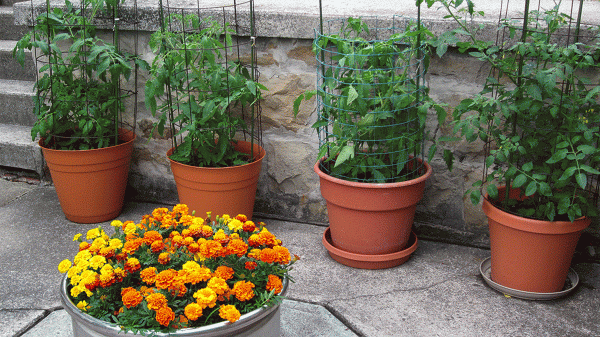Dripping Gardening March 19

Last week I mentioned a bit about gardening in containers and raised beds. After the article appeared several folks contacted me about the suitability of containers and raised beds for growing their tomatoes, “…surely it wouldn’t be as effective as growing them right in the ground?”
After a number of years of watching gardeners attempt to grow tomatoes, I have learned that there definitely is no one single way to do it. Container tomato gardening can be just as good as traditional tomato gardening.
Growing tomatoes in containers, however, is almost always an adventure. It can be incredibly rewarding or flat out disastrous. Sometimes epic failure can happen for reasons beyond your control like tomato blight or a ridiculously wet or intensely hot summer. Nevertheless, there are some common mistakes that, if they can be avoided, will vastly increase your chances of successfully growing tomatoes in containers.
First off, I advise that you avoid using small containers, when it comes to tomato containers, bigger is always better. The bigger your container, the more soil it will hold. The more soil you have, the better the soil holds water. Also, the more soil, the more available nutrients for your plants. Consistent water and food are two of the most critical elements for happy, healthy tomato plants and large harvests.
Most plants need to be planted rather shallowly; however, tomatoes are different. Plant your tomatoes deeply so that roots will develop from stems that are underground and your tomatoes will be stronger and healthier. When planting a tomato seedling, dig a hole so that most of your plant is covered by soil (though you will want to make sure you have leaves sticking out of the soil). Make sure that you remove all the leaves and branches below the soil line. The stem you buried will grow roots and make for a much stronger, healthier plant. So big deep containers are best.
Another problem area is watering. Watering your tomato plants properly is probably the main key to tomato success. Too much water and the plants drown; too little and you get blossom end rot. Inconsistent watering can also get you blossom end rot, split tomatoes, and stressed plants. A critical thing you must do for tomato success (and the most difficult if you are using conventional pots instead of self-watering drip system) is to keep the soil in your pots consistently moist, not wet mind you, but damp.
Before you water, check if your soil is already moist. To do this put your finger into the soil down to about your second knuckle. Add water if the soil feels dry to the touch at your fingertip. Also, do not forget about drainage! Containers drain, or at least they need to drain, so make sure your pot has large holes in the bottom so excess water can drain out. Pot feet are also a good idea if you have your pot on a patio or non-porous surface. Add water until it drains out the bottom of your pot. That way you will know that all of the roots, even those at the bottom of the pot, have gotten watered. Another great way to control water to your containers is to use a self-watering container, such as a grow box. You may want to try the Earthbox or The Grow Box brands, I have seen both used with success.
While too much water is the most common problem, too little water is an issue as well. The amount of water your tomato plant needs will depend on a few things, including the weather. Wind, heat, humidity, the size of your pot, and the kind of potting soil you use will all affect how often you need to water. By mid-season, a large tomato plant may need watering at least once a day and sometimes twice. Also, when you water, make sure to really soak your plants—if you just give them a sip, the water will only wet the top layer of soil. When you water, try to water the soil directly instead of the leaves because wet leaves can lead to fungus. Don't bother with water crystals, they are expensive, and tests have shown that they aren't particularly effective. Another trick with tomatoes is to water them in the morning, as plants take up and use water more efficiently in the morning.
Avoid overcrowding your pots. Putting lots of plants in one pot may seem like a good idea, but it usually is counterproductive. Unless my pot is tremendous (more like a raised bed) I only put one tomato plant per pot. To get an idea of minimum size, I have successfully grown one huge tomato plant in a large reusable grocery bag (yes, I do this kind of thing just for fun) and that's about as small as I'd go per plant.
Remember that tomatoes are sun-lovers and need full sun, which means that they need unobstructed, direct sunlight for 6-8 hours a day, no cheating or skipping. Many people chronically overestimate how much sun an area gets. Figure sun exposure out, either with a watch or a sunlight meter, before you position your pots. Also, the amount of sun that hits a spot can change dramatically over the growing season, so re-check every week or so to make sure there is nothing obstructing the plants' access to sunlight. But remember, full sun in Texas is not the same as full sun in most eastern States. A bit of afternoon dapple shade from a nearby tree might not be a bad thing.
Also remember that tomatoes are heavy feeders and need to be fertilized if you aren't using a pre-fertilized potting soil. Most potting mixes have very few of the nutrients that your plants require to grow and be healthy, so you will need to add those nutrients to the soil or supplement the nutrients already present if your mix is heavy on compost. Remember a few paragraphs back I advised you to water your tomatoes until water ran out the drainage holes of your pot? That water draining out is also washing away the nutrients that your plants need to be healthy so you will need to fertilize! There are many fertilizers to choose from, but some good options are an all-purpose, organic slow-release fertilizer or one designed especially for growing tomatoes or vegetables, which you can mix into potting soil. In addition, you may consider adding a diluted fish emulsion/seaweed liquid once every week or two, or calcium, either in the form of lime or liquid calcium. If you start seeing black at the ends of your tomatoes, you probably have blossom end rot, which can be from watering issues and/or a lack of calcium in your soil.
Stake or cage you tomato plants, not doing so is a chronic mistake for gardeners. It is easy to forget how fast tomatoes grow and, consequently, gardeners often fail to stake or cage them until they are huge and unwieldy. It is much better to set up your cages or stakes before your tomatoes get too big.
Tomatoes are the queens of most gardens, the most homegrown vegetable in America, and so much tastier than any store-bought tomato can dream of being. With the few tips above, I hope you will get out and plant some in your garden or in a container on your porch.


